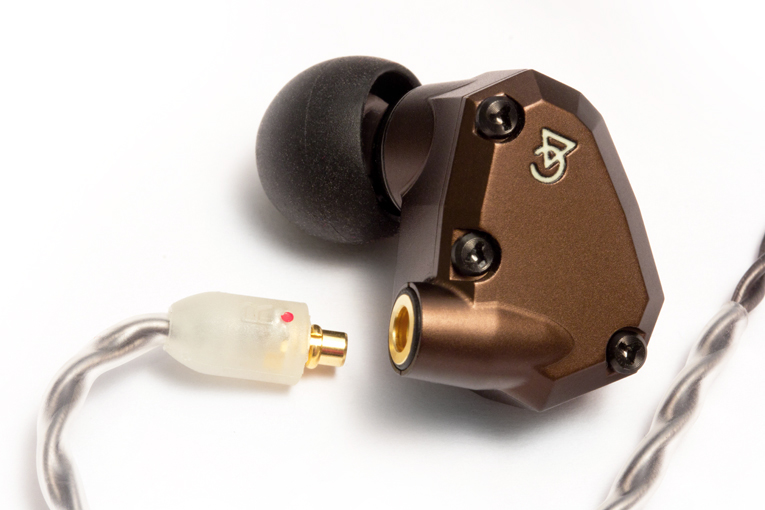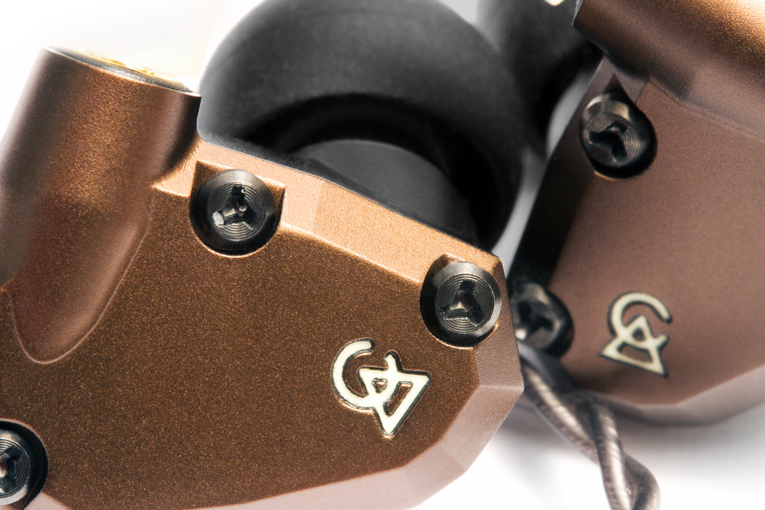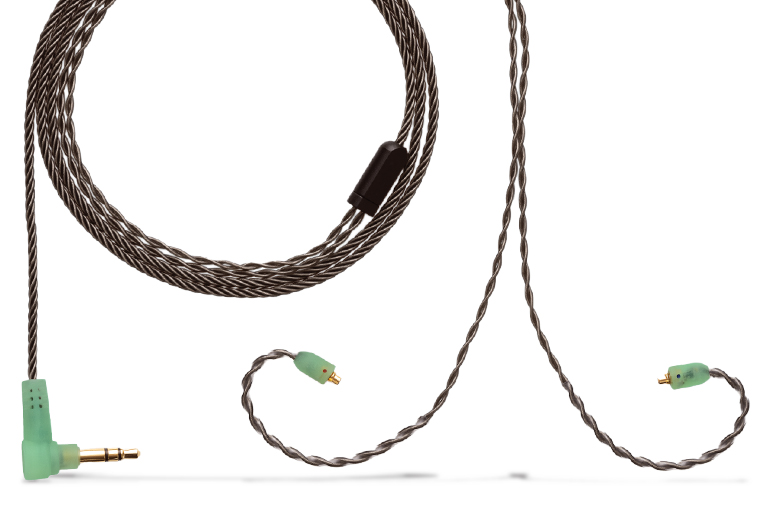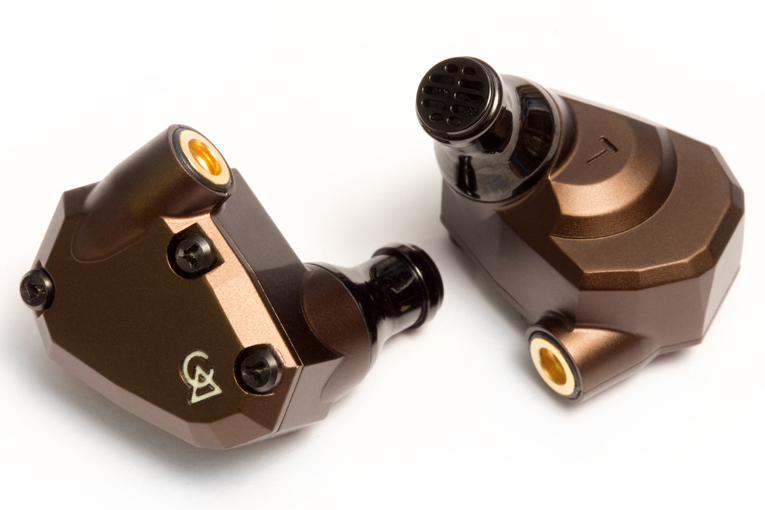Sound: 









Value: 









(Read about our ratings)
Measurements can be found by clicking this link.
Campfire Audio makes so many different earphones it was hard to figure out which ones I should review, so last time I talked with company founder Ken Ball, I just asked him. He was pretty excited about two then-new earphone models, the Holocene and the Mammoth. Asked what the difference was, he said that the Holocenes have a more “reference” response, and that the Mammoths have more bottom end, with a response closer to the Harman curve. This left me thinking I’d prefer the Mammoths, but just in case, I asked Ball if he wouldn’t mind sending a test sample of the Holocenes, too.
The Holocene earphones ($649, all prices USD) are a two-way design. Each earpiece packs two balanced-armature drivers for the mids and bass, and one more for the highs. They’re mounted in a 3D-printed acoustical chamber, then enclosed in an anodized-aluminum shell. As you’ll learn if you read my interview with Ball, Campfire prefers to do the tuning of its multi-driver models acoustically, rather than using an electrical crossover with resistors, capacitors, and inductors. The Mammoths ($549), even though they share the same aluminum enclosure (anodized in blue rather than the Holocenes’ bronze), are radically different: a three-way design with balanced armatures for highs and mids, and a 10mm dynamic driver for the lows.

For the most part, the Holocenes seem pretty standard-issue for audiophile earphones. They use over-ear cable routing—which, if done right, allows a more secure, ear-filling fit. They feature detachable cables with MMCX connectors on the earphones, so enthusiasts can substitute aftermarket cables or even snap-on true wireless modules. The Holocenes are artisanal, rather than mass-produced, because they’re made in Campfire Audio’s factory in Portland, Oregon.
The published specs for the Holocenes are puzzling. Impedance is rated at 5.4 ohms at 1kHz, which is very low, but we’ve seen similar specs on occasion. What’s weird is the sensitivity spec: 94dB at 1kHz with a 6.99mVrms signal. The international industry standard specifies a 500Hz signal with a strength of 1mW, calculated for the rated impedance—or 73mVrms. So the industry-standard test signal level will result in a rated sensitivity that’s 20.4dB higher. Fortunately, we measure sensitivity ourselves using laboratory-grade equipment—with a 1mW signal averaged from 300Hz to 3kHz—and you can see the results in the Measurements section, linked to at the top of this review.
In the box
The Holocenes come generously accessorized. The cable is 4′ (1.2m) long, tipped with a 3.5mm (1/8″) plug on the source end and MMCX connectors on the other ends. The molding around the connectors glows in the dark, as do the Campfire Audio logos on the earphones. Should you need a cable with an inline microphone or a balanced connection, Campfire Audio offers those, and they’re readily available from other companies, too.

The case is so cool-looking that you won’t care if it’s a little chunky, at about 1 3/4″ (4.4cm) thick. It’s crafted from Seaqual yarn (formulated 100% from recycled materials), printed with a funky space graphic, and fitted with a fat zipper that glows in the dark (just the handle and the slider of the zipper, not the teeth). It’s lined inside with a soft material. Campfire also supplies a little two-pocket drawstring case in which you can carry spare eartips.
The eartip supply is also generous: Final silicone tips in four sizes, generic silicone tips in three sizes, and foam tips in three sizes. There’s also a cleaning tool and a Campfire Audio pin.
Use
I know from past experience that thanks to my extra-large ear canals, none of the tips Campfire supplies would fit me, so I substituted SpinFit CP100 XL tips. And as is usually the case with Campfire earphones, the Holocenes nestled comfortably and securely into my ears, and provided excellent acoustical isolation from external sounds.
Despite the confusing sensitivity spec, the Holocenes are easy to drive—my Samsung Galaxy S10 phone got them cranking loudly without breaking a sweat. (Although I have to confess that I would have been thrilled to see my phone break a sweat.) However, due to their aggressive impedance swing (which you can see in the Measurements section), I recommend pairing the Holocenes with a DAC-amplifier that has a low output impedance—such as the AudioQuest DragonFly Cobalt or the EarMen Eagle, or most of the other ones I’ve measured.
Sound
The Mammoth and Holocene earphones arrived in the same shipment. So I wouldn’t know (or, at least, remember) which was which, I quickly unpacked them without looking at the packaging. I broke them in for ten hours, then gave them a spin with familiar test tracks such as Tracy Chapman’s “Fast Car” (Tracy Chapman, 16-bit/44.1kHz FLAC, Elektra/Qobuz).
Right away, I noticed that earphones #1 had clearer treble, and sounded “pretty well-balanced and spacious,” according to my notes, while #2 sounded “bloated, softer, and less detailed and lively.” Listening to Camille Thurman’s Inside the Moment (320kbps Ogg Vorbis, Chesky/Spotify), I described the sound of earphones #1 almost exactly the same way, but wrote of #2: “Nope. Seems veiled and has a bit of cupped-hands coloration [as if the singer had her hands cupped around her mouth), and the reverberance seems phasey and unnatural.”
I was pretty sure by now that #1, the earphones I liked, were the Mammoths, and #2 were the Holocenes—but a quick glance at the packaging showed that my preconceived notions were wrong. Turns out #1 were the Holocenes, and #2—the earphones I didn’t like—were the more Harman curve-ish Mammoths. (Once again, I’ll refer you to the link to the Measurements section at the top of the page, where you can see how the frequency-response measurements of these earphones compare to the AKG N5005 earphones, which conform closely to the Harman curve.)

Thinking my reaction might change with greater familiarity, I took both sets of earphones along on my daily dog walks, but after a few days, I listened only to the Holocenes, which I enjoyed much more than the Mammoths. I liked almost everything I heard when I was using the Holocenes—the overall tonal balance, the lack of overt colorations, and the excellent sense of space.
Here’s an example: When I listened to the Ornette Coleman tune “Ramblin’,” from Charles Lloyd & the Marvels’ Tone Poem (24/96 FLAC, Blue Note/Qobuz), I loved the sense of different-sized “sound bubbles” I got from the Holocenes, with Lloyd’s tenor sax occupying a small bubble in the center; the steel guitar and electric guitar each occupying its own, larger bubble to the right and left, respectively, of Lloyd; and the drums seeming to encompass the whole band, then the reverberance of the saxophone wrapping around all the other sounds. This isn’t an accurate portrayal of the soundstage of this recording, but it’s as close as earphones can probably get without some sort of processing—and I found it compelling in its own right, especially the detail in drummer Eric Harland’s insistent hi-hat, topped off (apparently) with a tambourine.
I was shocked and delighted to see King Crimson’s Discipline (24/44.1 FLAC, Discipline Global Mobile/Qobuz) pop up on my Qobuz home page, because bandleader Robert Fripp had previously, and notoriously, refused to release anything more than a tiny sampling of the band’s catalog on streaming services. Discipline is easily one of my favorite albums; 40 years after its release, the music still sounds subversive, revolutionary, and inspired. I’ve heard it on innumerable audio systems and formats since I bought the original release on cassette in 1981, so I have a very solid idea of how it sounds “on average.”

I definitely liked what I heard through the Holocenes when I played “Frame by Frame,” which many fans consider to be the “proof of concept” tune for this iteration of the band. Truth be told, though, the Holocenes gave me my first sense, after all this time, that Discipline isn’t such a great recording. Granted, the mixing engineer had a lot to sort out in “Frame by Frame”—gamelan-like interlocking parts played on two electric guitars, hyper-percussive bass pummeling on Chapman Stick, touches of guitar synthesizer, and drumming that alternates between insanely busy and daringly primal passages. The Holocenes did as good a job of sorting out the flurries of notes in “Frame by Frame” as I’ve ever heard, but what they told me that I hadn’t noticed before was that there’s really not much ambience in this recording, even for the time—digital reverbs were rare then, and what little reverb was applied sounded like a second-rate plate reverb with the treble accidentally turned down on the return feed. Especially in comparison with the awesome ambience the Holocenes delivered on the Charles Lloyd recording, it sounded pretty meh—but kudos to the Holocenes for revealing what previously escaped my notice.
I did notice, though, that the Holocenes seemed a little light in the low end—something that also crossed my mind in my earlier listening. They didn’t sound thin, though, which made me suspect that the top end had been rolled off a bit to give the earphones a more balanced sound. I knew the perfect test track for this: Holly Cole’s rendition of Tom Waits’s “Train Song” (Temptation, 16/44.1 FLAC, Blue Note/Qobuz), which starts with powerful, deep double-bass notes accompanied by multiple shakers, woodblocks, bells, cymbal, triangle, bongos, and more instruments I can’t name. Even the super-high-pitched bells that accent the end of two of the tune’s verses came through clearly, although the percussion didn’t sound as excitingly etched (sorry, best phrase I could come up with) as they do with treblier audiophile-oriented earphones I’ve heard. Other than maybe a subtle touch of extra zip in the mid-treble—in the region somewhere between 6 and 10kHz, I guessed—Cole’s voice sounded natural, smooth, and uncolored.

The opening double-bass notes of this recording of “Train Song” are notorious for pushing small subwoofers into distortion, but through the Holocenes, the notes didn’t have the power I’m used to hearing. So just to give the low end another check, I played Kanye West’s “Love Lockdown” (808s & Heartbreak, 320kbps Ogg Vorbis, Universal Music Group/Spotify). The deep, powerful opening tones were certainly present through the Holocenes, but they were not as high in level as I’m used to hearing. Because the extension was there, but the level was low, it was kind of like playing a big set of tower speakers but turning the bass down about 6dB.
Comparison
Unfortunately, I took off for my holiday break without bringing a huge selection of earphones with me for comparisons. But besides the Mammoths, I did remember to bring the ones I most wanted to compare with the Holocenes: the Meze Audio Rai Penta earphones ($1099), a hybrid design with four balanced armatures and a dynamic bass driver packed into a compact aluminum enclosure. Like the Holocenes, the Rai Pentas are the result of meticulous acoustical tuning.
Even the Rai Pentas, which I consider slightly light in the bass, had more low-end power than the Holocenes on “Love Lockdown,” although both earphones had a pleasing, natural-sounding tonal balance. “Love Lockdown” doesn’t have enough else going on to be useful in judging audio quality, so I went to another, but radically different, tune that I use a lot: the version of “What’s New?” from Frank Sinatra Sings for Only the Lonely (24/48 FLAC, Reprise/Qobuz).
I was lucky enough to hear the 2018 remastered version of this tune in the control room at Capitol Studios in Los Angeles, where it was originally produced (albeit on much different equipment). No, my aural memory isn’t good enough to remember exactly what that sounded like, but I kind of got the vibe. I’d say that through the Holocenes, Sinatra’s voice sounded a little smoother—which, given that it’s Sinatra, is probably more accurate. However, the bass accompaniment—played pizzicato on multiple double basses—sounded much more vivid through the Rai Pentas, offering a substantially stronger rhythmic pulse; through the Holocenes, the basses were mostly buried in the mix. The Rai Pentas had more of a lower-treble peak that gave Sinatra’s voice a bit of added edge, but they also made his voice sound fuller.
Desperate to narrow down my opinion of how these products compare, I went to one of my most trusted test tunes: the live version of James Taylor’s “Shower the People” from the Live at the Beacon Theatre DVD (256kbps MP3, ripped digitally from the DVD’s 2.0 16/44.1 soundtrack, Sony). Both earphones sounded clear, ambient, and smooth on this tune, but I preferred the extra fullness (and to my ears, extra naturalness) that the Rai Pentas lent to Taylor’s acoustic guitar and vocals. Although I have to point out that the Rai Pentas are 69 percent pricier, so they ought to sound better.
Conclusion
I think the Holocenes are one of the nicest options in audiophile-oriented earphones priced between $500 and $1000. They offer a great mix of excellent clarity and a natural-sounding tonal balance, and they have no ergonomic flaws I could find. The Holocenes definitely aren’t for bassheads—but most audiophiles aren’t bassheads. And unlike so many audiophile earphones, the Holocenes don’t overemphasize the treble, so whether you’re listening to voices, saxophones, guitars, cymbals, or whatever, they’ll sound realistic.
. . . Brent Butterworth
Associated Equipment
- Smartphone: Samsung Galaxy S10.
- DAC-headphone amplifier: AudioQuest DragonFly Cobalt, EarMen Eagle.
Campfire Audio Holocene Earphones
Price: $649.
Warranty: One year.
Campfire Audio
2400 SE Ankeny
Portland, OR 97214
Phone: (855) 204-1492, (503) 853-8608
Website: www.campfireaudio.com





